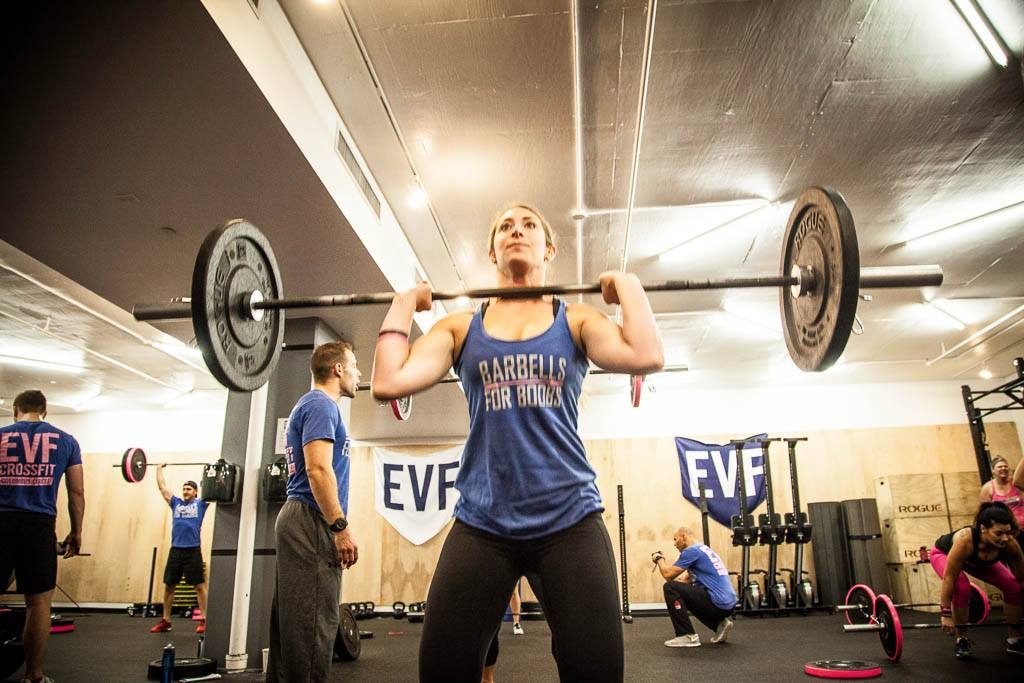Tips for beginners: Getting started with CrossFit
Set yourself up for success with Coach Jenna’s tips on getting started with CrossFit
Check your ego. Come in with an open mind and a willingness to learn. No matter your athletic background, it’s important to come into class with a beginner’s mentality. Technique and proper mechanics are paramount. Learn and perfect your mechanics, establish consistent movement patterns and, only then, ratchet up the intensity. For the first few months of CrossFit, you won’t be at the point where you’re collapsing on the floor after a workout — and that’s OK! Consistent proper execution of the movements will allow you to be more efficient and decrease the risk of injury once you increase the intensity.
Start slow. The majority of CrossFit injuries occur from doing too much too soon. The Rx on the board is by no means a must-follow — in fact, you’ll only see about 10 to 15 percent of any given class doing the workout completely as prescribed. The entire class is customizable to your abilities and limitations. Just because you see pull-ups or heavy snatches in a workout doesn’t mean you shouldn’t come to class! The coach will be able to help you find the scaling options and movement progressions that are right for you.
Prioritize mobility and recovery. You’ll learn very quickly where your mobility shortcomings are. Most limitations in the squat, snatch and clean have nothing to do with strength and everything to do with mobility. The more easily you can get into difficult positions (like the overhead squat), the more successful you’ll be in workouts. Recovery is very important as well. The importance of stretching post-workout cannot be overstated. Lack of stretching leads to tight muscles, and tight muscles lead to injuries. Carve at least 10 minutes out of your day to stretch and save yourself unnecessary muscle aches and injury down the road. Not sure where to start? Check out our daily blog posts for Coach Alicia’s mobility suggestions for the day. ROMWOD is another awesome tool. For the cost of a few cups of coffee, you can get daily mobility and stretching programming catered to CrossFit athletes. Add in a few sessions a week and you’ll be amazed at how much your performance and recovery improve.
Write everything down. One of the best things about CrossFit is that it’s measurable. It’s all about data — pounds lifted, Fran times, 2K row times, and on and on. Your results over time (both short term and long term) will show, very specifically, how you have improved. That said, it’s impossible to see improvements and progress unless you’re diligent about recording your workouts. We might do a benchmark workout like “Karen,” 150 wall balls for time, and then not test it again for 6 months or so. The chances that you’ll remember, months later, whether your previous time was 8:21 or 8:41 are quite low. Write it down and you won’t be playing any guessing games with your fitness.
Set a schedule and stick to it. I recommend four days per week for beginners. This allows your body to adjust to the new stimulus while also giving you time to recover between workouts. Depending on where your weaknesses are, you may want to have more of a bias towards 360 classes in the beginning, especially if cardiovascular conditioning is where you struggle. A good schedule to start with is Monday, Tuesday, Thursday, and then Friday or Saturday. Once you adjust to the workload, then you can look at adding a fifth day. And don’t drop EVF 360 once you’re feeling more comfortable in CrossFit. Longer conditioning sessions will help you keep your work capacity high.
Don’t overtrain. Take AT LEAST one complete rest day per week. I also recommend another day of active recovery — a long, slow row, a yoga class, or just a long walk and some stretching. Remember: A 5K, a spin class, EVF 360 or any other high-intensity workout does not count as rest.
Be mindful of your nutrition. It’s very common to notice an increased appetite that comes with increasing workout intensity, but CrossFit doesn’t give you carte blanche to eat whatever you want, whenever you want. Like Greg Glassman, the founder of CrossFit says, “Eat to support exercise, not body fat.” Not sure how to fuel your workouts properly? Ask a coach or look into our EVF Nutrition program.
Follow the above instructions and you will absolutely be successful in CrossFit. Trust your coaches, be safe and smart, and, most importantly, have fun!
2017 11 01
